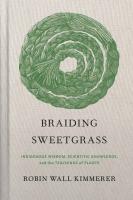
Kimmerer has the scientific training--rational, evidence-based, data-driven--of a botanist; the indigenous culture, worldview, and beliefs of a Potawatomi Anishinaabe; and the language, spirit, and skill of a poet. In this book she wonderfully melds those three ways of seeing, of knowing, of understanding and communicating. She beautifully shares an ecological message of the possibility of harmonious co-existence with plants and nature, a perspective deeply supported by science. More than any other book I know, it spoke equally to my head, my heart, and my soul.
If there's a single concept at the core of the book, it's reciprocity. Take care of the things that take care of you. Plants and nature are not consumable resources to be plundered and used up; they are equal beings sharing space--sharing the planet--with us, deserving of respect and care. We need to learn gratitude for the gifts they provide us, to listen to them, and to see to their health the way they see to ours.
The book is a collection of essays, a moment or experience from Kimmerer's life the heart of each one, surrounded by ruminations on the indigenous perspective informing it, the science involved, and her ruminations.
In "Wisgaak Gokpenagen: A Black Ash Basket," she reflects on her experience learning to make traditional baskets from black ash trees, including a study she helped one of her graduate students conduct investigating a decline in the population of the trees. Because new shoots need a certain amount of space and sunlight to achieve a healthy height, they found the trees didn't reproduce optimally when left entirely alone; new growth emerged best in areas where storms or disease had culled some of the older growth. The healthiest, most replenished populations of black ash were the ones near basket makers, who selectively harvested a carefully spaced, dispersed portion of the trees. The science showed the wisdom of the traditional practices.
Black ash and basket makers are partners in a symbiosis between harvesters and harvested: ash relies on people as the people rely on ash. Their fates are linked.
Similarly, in "Mishkos Kenmawen: The Teachings of Grass," Kimmerer tells of how she helped a different graduate student conduct studies of sweetgrass to show the traditional methods of harvesting are healthiest for the grass. Unharvested plots of sweetgrass struggled to survive, where the plots that were thinned by harvesting allowed what remained to grow, spread, and thrive.
Our elders taught that the relationship between plants and humans must be one of balance. People can take too much and exceed the capacity of the plants to share again. That's the voice of hard experience that resonates in the teachings of "never take more than half." And yet, they also teach that we can take too little. If we allow traditions to die, relationships to fade, the land will suffer. These laws are the product of hard experience, of past mistakes. And not all plants are the same; each has its own way of regenerating. Some, unlike sweetgrass, are easily harmed by harvest. Lena would say that the key is to know them well enough to respect the difference.
It's about seeing ourselves not as dominant over nature, but in relationship with nature. A relationship characterized by gratitude for the exchange of gifts. Reciprocity.
The guidelines for the Honorable Harvest are not written down, or even consistently spoken of as a whole--they are reinforced in small acts of daily life. But if you were to list them, they might look something like this:
Know the ways of the ones who take care of you, so that you may take care of them.
Introduce yourself. Be accountable as the one who comes asking for life.
Ask permission before taking. Abide by the answer.
Never take the first. Never take the last.
Take only what you need.
Take only that which is given.
Never take more than half. Leave some for others.
Harvest in a way that minimizes harm.
Use it respectfully. Never waste what you have taken.
Share.
Give thanks for what you have been given.
Give a gift, in reciprocity for what you have taken.
Sustain the ones who sustain you and the earth will last forever.
That's a central message from the book, though far from the only one. There are stories from Kimmerer's life, history, traditional tales, science, and a much wider variety of topics than the theme of harvest that I have highlighted here. Another, for example:
The diversity of salmon in the river--Chinook, Chum, Pink and Coho--ensured that the people would not go hungry, likewise the forests. Swimming many miles inland, they brought a much-needed resource for the trees: nitrogen. The spent carcasses of spawned-out salmon, dragged into the woods by bears and eagles and people, fertilized the trees as well as Skunk Cabbage. Using stable isotope analysis, scientists traced the source of nitrogen in the wood of ancient forests all the way back to the ocean. Salmon fed everyone.
Reciprocity. In myriad ways, from different perspectives, settings, and scales, this book describes nature as a complex interconnectedness of many different beings, many different forms of life, humans one among many.
I dream of a world guided by a lens of stories rooted in the revelations of science and framed with an Indigenous worldview--stories in which matter and spirit are both given voice.
Kimmerer has certainly accomplished her dream in this book.
